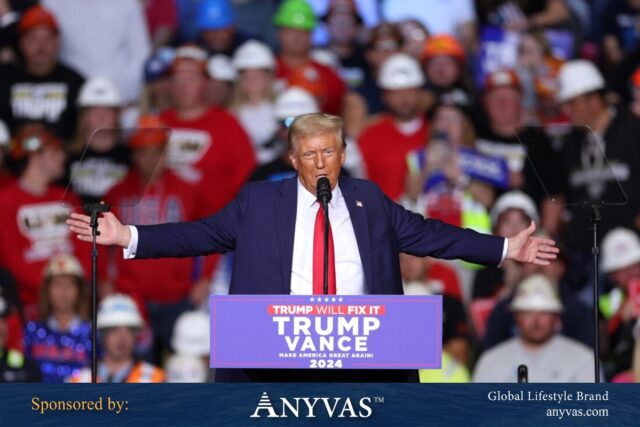The victory of Donald Trump in the 2024 U.S. Presidential election marks a pivotal moment for the American economy, with implications that will resonate across industries, global markets, and business strategies. Known for his bold economic policies during his first term, Trump’s return presents a unique combination of opportunities and risks for U.S. businesses and international trade. In this article, we will explore how Trump’s policies might impact the business landscape, providing a nuanced analysis of the economic changes that could lie ahead.
Economic Growth and Tax Policies: Boosting Corporate Profitability
One of the key highlights of Trump’s first presidency was his tax cuts, particularly the 2017 Tax Cuts and Jobs Act, which significantly lowered corporate tax rates from 35% to 21%. This move was widely praised by businesses, particularly large corporations, as it increased after-tax profits and gave companies more freedom to invest in expansion. With Trump’s re-election, businesses might expect a return to such pro-business tax policies, which could further stimulate economic growth.
According to data from the Tax Foundation, businesses experienced an initial increase in capital investment post-2017 tax cuts, reflecting a business-friendly environment. The potential reinstatement of these tax cuts could lead to further growth in sectors such as technology, manufacturing, and energy, where large capital expenditures are common. Lower taxes typically translate to higher profits, which companies can reinvest in innovation, expansion, and hiring, leading to an overall uptick in business activity.
However, while tax cuts benefit corporations, they often come with trade-offs, including increasing the federal deficit. This aspect could affect government spending and lead to higher interest rates as the government borrows to finance its expenditures, creating potential risks for long-term economic stability.
Trade Policy: A Double-Edged Sword
Trump’s approach to international trade—particularly his “America First” stance—has led to significant shifts in global supply chains. By imposing tariffs on imports from China and renegotiating trade deals, such as the USMCA (United States-Mexico-Canada Agreement), Trump has sought to protect American manufacturing and reduce the trade deficit. For businesses in sectors like steel, automotive, and agriculture, these policies have often been seen as advantageous, protecting domestic industries from foreign competition.
However, the long-term effects of protectionism are more complex. While some businesses might benefit from tariffs, others could face higher costs for raw materials and components sourced from abroad. According to a Harvard Business Review report, industries reliant on global supply chains—such as technology and consumer goods—may struggle with higher production costs and delays due to tariff-induced bottlenecks. Furthermore, trade wars could escalate, leading to retaliatory tariffs that could harm businesses dependent on exports.
For global businesses, Trump’s return could signify a more unpredictable international trade environment. Companies will need to carefully monitor tariff policies and adjust their global strategies accordingly, ensuring that they are prepared for any shifts in trade relations, particularly with China and the European Union.
Labor Market: Skilled Workforce and Immigration Policies
Another area that could significantly impact businesses under Trump’s return is labor market policies. During his first term, Trump’s immigration policies limited the flow of skilled workers into the U.S., particularly in industries like tech, healthcare, and engineering. While this approach sought to prioritize American workers, it also created challenges for businesses that rely on a diverse and skilled labor force.
For industries such as technology and healthcare, which have a heavy reliance on international talent, Trump’s stance on immigration could create significant challenges. According to a National Foundation for American Policy report, stricter immigration policies have led to a reduction in the number of foreign-born workers in critical STEM (Science, Technology, Engineering, and Mathematics) fields. This can hinder innovation and growth, particularly for startups and high-tech companies that rely on talent from abroad to maintain a competitive edge.
Conversely, businesses in industries like construction or manufacturing might benefit from Trump’s focus on hiring American workers, especially in sectors where labor shortages are common. However, this could also increase labor costs and reduce productivity if the labor pool is unable to meet the demand for skilled workers.
Regulatory Environment: Deregulation vs. Consumer Protections
Trump’s deregulatory approach, particularly in sectors like energy, finance, and healthcare, has been a hallmark of his first term. By rolling back environmental and financial regulations, Trump aimed to reduce the compliance burden on businesses, making it easier for them to operate and expand. The potential for a return to these deregulatory policies could provide businesses with more flexibility, especially in industries like oil, gas, and coal, where regulations can be particularly burdensome.
However, this regulatory rollback may also lead to increased risks for consumers and the environment. For example, loosening environmental regulations could lead to higher carbon emissions, affecting sustainability-focused businesses and industries that prioritize environmental responsibility. Companies in the renewable energy sector or those with corporate social responsibility (CSR) goals may find themselves at odds with an administration that favors deregulation at the cost of long-term environmental stability.
Final Reflections: Navigating the Shifting Landscape
Donald Trump’s return to the White House brings both opportunities and risks for businesses in the U.S. and abroad. On one hand, tax cuts, deregulation, and trade protectionism could provide immediate relief and growth prospects for certain industries, particularly manufacturing and energy. On the other hand, the challenges of rising labor costs, global trade tensions, and the potential for higher interest rates pose risks that businesses must carefully navigate.
For companies looking to thrive in this shifting environment, adaptability will be key. Businesses will need to stay informed about policy changes, adjust their strategies accordingly, and remain flexible enough to pivot in response to new economic realities. Whether benefiting from Trump’s business-friendly policies or grappling with the complexities of protectionism and labor shortages, businesses will need to make strategic decisions to position themselves for success in the evolving economic landscape.
To get more insights from our Editorial section, please click here.



















